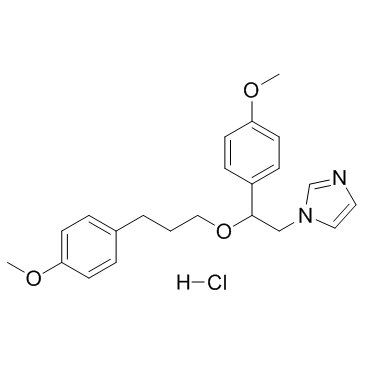SKF-96365

SKF-96365 structure
|
Common Name | SKF-96365 | ||
|---|---|---|---|---|
| CAS Number | 130495-35-1 | Molecular Weight | 402.914 | |
| Density | N/A | Boiling Point | 556ºC at 760mmHg | |
| Molecular Formula | C22H27ClN2O3 | Melting Point | 119 °C | |
| MSDS | USA | Flash Point | 290.1ºC | |
Use of SKF-96365SKF-96365 hydrochloride is a non-selective TRP Channel blocker. |
| Name | 1-[2-(4-methoxyphenyl)-2-[3-(4-methoxyphenyl)propoxy]ethyl]imidazole,hydrochloride |
|---|---|
| Synonym | More Synonyms |
| Description | SKF-96365 hydrochloride is a non-selective TRP Channel blocker. |
|---|---|
| Related Catalog | |
| Target |
TRP Channel[1] |
| In Vitro | SKF-96365 exhibits potent anti-neoplastic activity by inducing cell-cycle arrest and apoptosis in colorectal cancer cells. SKF-96365 inhibits hERG current in a concentration-dependent manner[1]. SKF-96365 can induces cytoprotective autophagy to delay apoptosis by preventing the release of cytochrome c (cyt c) from the mitochondria into the cytoplasm. Mechanistically, SKF-96365 treatment inhibits the calcium/calmodulin-dependent protein kinase IIγ (CaMKIIγ)/AKT signaling cascade. Overexpression of CaMKIIγ or AKT abolishes the effects of SKF-96365 on cancer cells, suggesting a critical role of the CaMKIIγ/AKT signaling pathway in SFK-96365-induced biological effects[2]. |
| In Vivo | SKF-96365 inhibits CRC cell growth in vivo. SKF-96365 treatment results in a decrease of p-CaMKII and p-AKT as well as an increase in LC3-II, cleaved PARP, caspase-3, and caspase-9 in mice[2]. |
| Animal Admin | Mice: Five to six-week-old female athymic BALB/c mice are inoculated into the right oxter with HCT116 cells. When the diameter of the subcutaneous tumor reaches approximately 0.5 cm, animals are randomLy assigned to the vehicle, SKF-96365 alone, HCQ alone or SKF-96365+HCQ. SKF-96365 is applied (20 mg/kg) and HCQ is applied (60 mg/kg) daily for 14 successive days by i.p. injection. Tumor sizes and volume are determined. Eight mice are included in each group. Mice are sacrificed 24 h after the last treatment. The tumors are weighed and processed for western blot analysis or paraffin embedding[2]. |
| References |
| Boiling Point | 556ºC at 760mmHg |
|---|---|
| Melting Point | 119 °C |
| Molecular Formula | C22H27ClN2O3 |
| Molecular Weight | 402.914 |
| Flash Point | 290.1ºC |
| Exact Mass | 402.171021 |
| PSA | 45.51000 |
| LogP | 5.09300 |
| Appearance of Characters | solid | white |
| Vapour Pressure | 7.86E-12mmHg at 25°C |
| Storage condition | Store at RT |
| Water Solubility | H2O: >20 mg/mL |
| HS Code | 2933290090 |
|---|---|
| Summary | 2933290090. other compounds containing an unfused imidazole ring (whether or not hydrogenated) in the structure. VAT:17.0%. Tax rebate rate:13.0%. . MFN tariff:6.5%. General tariff:20.0% |
|
Mechanosensitive Ca²⁺-permeable channels in human leukemic cells: pharmacological and molecular evidence for TRPV2.
Biochim. Biophys. Acta 1848(1 Pt A) , 51-9, (2015) Mechanosensitive channels are present in almost every living cell, yet the evidence for their functional presence in T lymphocytes is absent. In this study, by means of the patch-clamp technique in at... |
|
|
STIM1 phosphorylation triggered by epidermal growth factor mediates cell migration.
Biochim. Biophys. Acta 1853(1) , 233-43, (2015) STIM1 is a key regulator of store-operated calcium entry (SOCE), and therefore a mediator of Ca²⁺ entry-dependent cellular events. Phosphorylation of STIM1 at ERK1/2 target sites has been described as... |
|
|
ATP releases ATP or other nucleotides from human peripheral blood leukocytes through purinergic P2 receptors.
Life Sci. 145 , 85-92, (2016) Almost every eukaryotic cell releases ATP under certain conditions. The idea that ATP induces the release of ATP has been scantly investigated.We explored this possibility by assessing the rate of exo... |
| UNII:33BI32858P |
| 1H-Imidazole, 1-[2-(4-methoxyphenyl)-2-[3-(4-methoxyphenyl)propoxy]ethyl]-, hydrochloride (1:1) |
| MFCD00236407 |
| 1-{2-(4-Methoxyphenyl)-2-[3-(4-methoxyphenyl)propoxy]ethyl}-1H-imidazole hydrochloride (1:1) |
| SKF 96365 |
| SKF-96365 hydrochloride |
| SKF 96365 HCI |